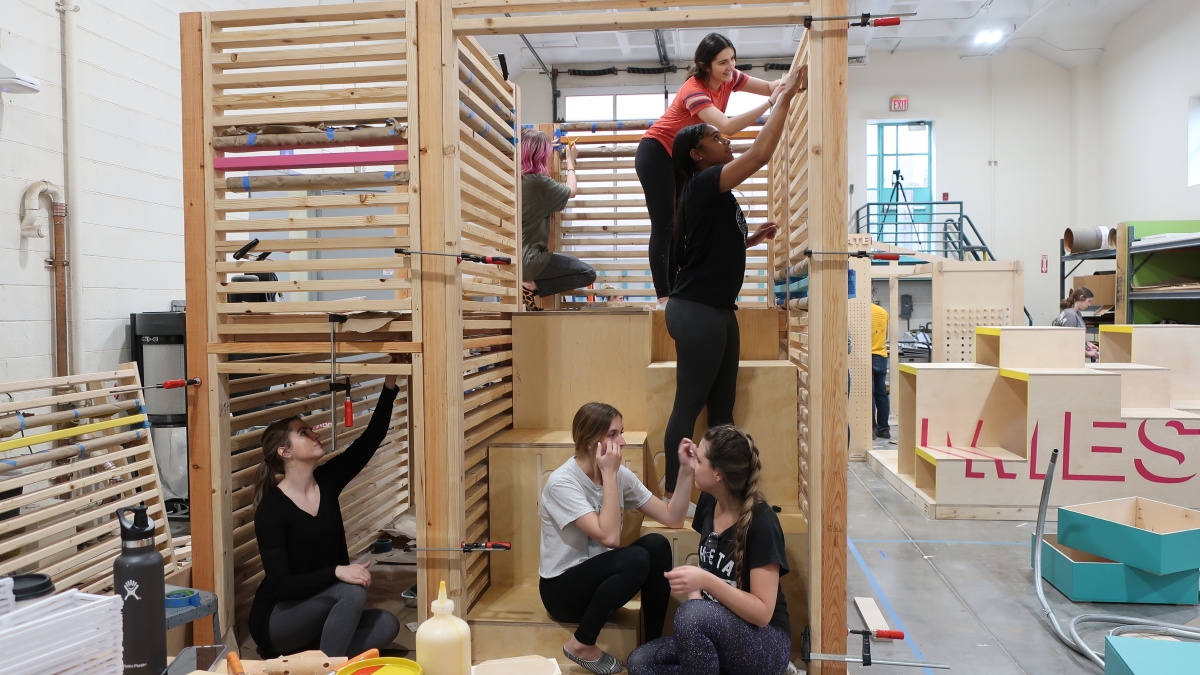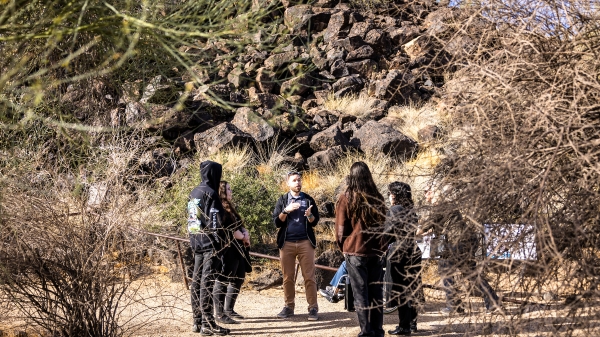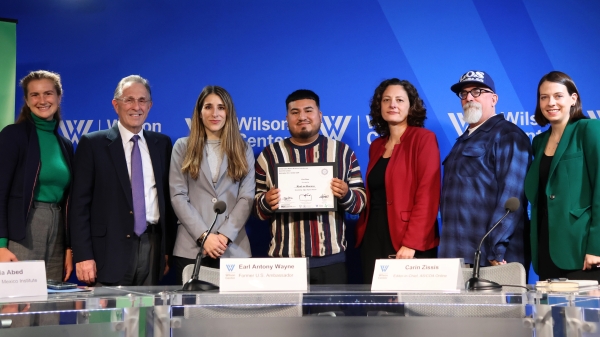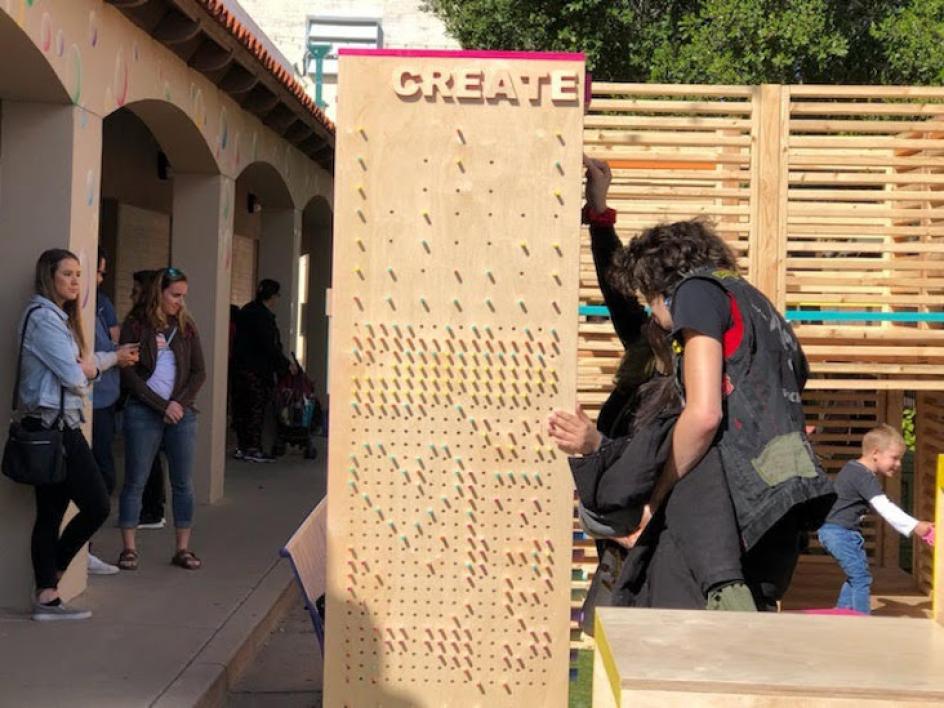Designing women (and men): Building unity in the community inside and out

The sounds of saws, drills and hammers fill a spacious workspace inside The Design School of the Herberger Institute for Design and the Arts on the Tempe campus of Arizona State University.
It is Feb. 13, the day before Valentine’s Day, and a group of students is putting the finishing touches on their labor of love — a community-inspired playground installation — to be unveiled at the city of Mesa’s Maker Fest and Prototyping Festival 2.0 in just a few days.
It’s a challenging project, made all the more exacting when you consider that a large percentage of the 37 students in the senior-level interior design studio class had little or no prior experience using power tools before tackling the project dubbed Inter PLAY.
The project takes another remarkable turn when, in an industry famously populated with more Nate Berkuses and Philippe Starcks than Kelly WearstlersNate Berkus, Philippe Starck and Kelly Wearstler are well known figures in the industry of interior design., it is revealed that Inter PLAY — five sturdy structures built for child-size exploration, discovery and play — was created by a design group overwhelmingly composed of women.
Remarkable to some outside of the industry, maybe — but not to Assistant Professor Milagros Zingoni, who instructs the studio class alongside Ben Ayers and Maria Delasotta. Zingoni says the female majority in the class — Interior Design Studio VI: Institutional Design — is actually very much in line with the national composition of interior design programs, which have been resignedly viewed as “feminine.”Lucina Kaukas Havenhand makes mention of this perspective in the 2004 study “A View from the Margin: Interior Design” (Havenhand, L. K. (2004). A View from the Margin: Interior Design. Design Issues, 20(4), 32-42. doi:10.1162/0747936042312002)
She is looking to change that.
“Across the country, interiors tends to be heavy in female ratio — no less than 80 percent,” she said. “The gender gap in architecture now — 15 years after I was a student — is almost 50-50, but back in the day, it was not. We hope to improve the gap in interiors as well and help eliminate stereotypes attached to the profession."
Milagros Zingoni
Six teams of students — 34 women and three men — united to build different pieces of Inter PLAY, currently on display in downtown Mesa. And while this particular class filled up with female students from two interior design classes, Zingoni is quick to point out that she had many requests from male students in other disciplines wanting to enroll in the hands-on, experiential design-build course.
The appeal and reasons for increased interest are obvious from her perspective.
“When I shifted to academia, what I missed the most was my hard hat and boots, being on the site, witnessing drawings become spaces,” said Zingoni, who owned and operated her own practice as a licensed architect and contractor in her native Argentina before moving to the U.S. “While I was a student, I had classes that required me to learn firsthand how to build a brick-and-mortar wall, or make the electrical connections through the walls. The idea was that you should learn how it is done properly, so you can tell your crew how you expect to have the work done.”
Zingoni’s class brought many of those practical elements together. “Most of my students have assembled IKEA furniture before,” she said. “Imagine coming from that to designing, calculating the structural integrity of their design, specifying materiality and fabricating their ideas as inhabitable spaces — all this was new for them and many described the feeling of having done something full-scale by their own hands as cathartic.”
Getting Inter PLAY into play involved a steep learning curve and a lot of muscle building for Zingoni’s students. She said there was a lot of soreness at the beginning (sheets of plywood can be heavy) but that by the end of the project, the students were almost lifting the plywood as if they were feathers.
“The first day of class I always ask the students if anyone does CrossFit,” Zingoni said. “The strongest student I ever had was a female student who used to do CrossFit and she could lift 200 pounds without effort. This was in a class where there were three men and four women — the closest gender distribution I have ever had — and she was the strongest of them all.”
In assembling the Inter PLAY project, Zingoni said the students would call on each other for specific needs, requesting “a tall person,” “a strong person” or “muscles.”
“I simply don’t see a difference between female and male students, and therefore I don’t see the limitations for my students to do design builds,” she said. “I think design builds have the potential to elevate both the discipline and our students, and when you elevate one aspect of an ecosystem, everyone benefits from it.”
Dejian Pan, one of the three male students in the design class that constructed Inter PLAY, said he enjoyed the collaborative spirit of the class and how everyone worked together to bring their ideas life.
"I was very proud that my friend Zili was the project manager of the entire class," Pan said in reference to studio classmate Zili Huang. "She made it look easy, but I know there was a lot of work behind it."
Katelyn Lentz, a student in Barrett, The Honors College, said working on the Inter PLAY project reinforced the importance of time management — something she knows a little bit about also being a student athlete on ASU's women's gymnastics team.
"I quickly learned how much planning goes into making a project successful and how important it is to stick to a schedule. Overall, it was a fulfilling and rewarding experience."
Katelyn's classmate Vanessa Lozano, also an honors college student, agrees.
"Inter PLAY taught us how to bring to life what started as a vision," she said. "We learned about creating an experience through design from the process of creating what started as drawings into full-scale, three-dimensional objects."
The students unveiled Inter PLAY at the Prototyping Festival 2.0 and Southwest Maker Fest in downtown Mesa on Feb. 16. It will be on display through April 15. Reflecting Zingoni’s work and research around community participation in various design build projects, Inter PLAY represents the second phase of an earlier installation dubbed Pause + Play that was designed and built by the ASU students and sixth-graders at Porter Elementary School in fall 2017. Zingoni says general findings show these type of exercises contribute to the development of critical reflection, dialogue, empathy and collaboration. She says she is looking forward to seeing whether the learning outcomes and feelings described have been useful for students working in the profession after graduation.
Many of Zingoni’s students have gone on to work in architectural and interior design firms. Some went on to form nonprofits and others went into politics and government. But most, she says, have stayed close to design. There is a very high demand for designers, according to Zingoni. She says many of her current seniors are already working 20 hours a week or more in design firms, adding that a number of alumni have approached her in search of new graduates to fill jobs only to learn that many design grads are already employed.
In celebration of Women’s History Month, local Arizona design professionals from various disciplines will share their stories and experiences of working in the industry in the student-led program dubbed “Women in Design: Equity for All” on March 15. The program runs from 1 to 4 p.m. at The Design School Bridge in The Design School on ASU’s Tempe campus. It is free and open to the public.
Zingoni, meanwhile, is enjoying national recognition for her work as an educator, having recently received the prestigious teaching excellence award from the Interior Design Educators Council. She calls the honor humbling.
“I only got the award because of the students that I have and have had. Doing design-build projects with communities takes three times more effort than what it used to take me to do the same course before involving the community, and just when I thought maybe I was in over my head, this award came along. I am honored. It’s inspiring me to do more for my students and the community.”
Top Photo: ASU Design School students put the finishing touches on the community-inspired installation Inter PLAY. Photo by Suzanne Wilson/ASU
More Arts, humanities and education

Petroglyph preserve celebrates 30th anniversary with ancient, modern tales
The Deer Valley Petroglyph Preserve provides a beautiful walk through a pristine desert where chuckwalla lizards are as plentiful as the cacti that comes in many shapes and sizes.It’s also a step…

Kaleidoscope short film contest inspires powerful binational filmmaking in its second year
“We come to this country not to steal anybody’s jobs but to take advantage of the opportunities that the rest ignore. We’ve been taking care of the American soil for many years. But our hands will…

ASU's Neal Lester reflects on life, death of poet Nikki Giovanni
When Neal Lester heard on Monday that poet and activist Nikki Giovanni had died, the news hit hard.Lester, the founding director of Arizona State University’s Project Humanities and a Foundation…









